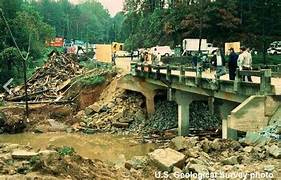In 1977, the United States experienced a tragic event that shook the small town of Toccoa, Georgia. The Kelly Barnes Dam, a hydroelectric plant located in Stephens County, collapsed, resulting in a catastrophic flood that claimed the lives of 39 people. This devastating incident left an indelible mark on the community and raised questions about dam safety across the country. The Kelly Barnes Dam, a 200-foot-tall structure owned by the Georgia Power Company, had been in operation for over four decades at the time of the incident. Construction of the dam was completed in 1919, and it provided locals with electricity for many years. Situated on Toccoa Falls, a popular tourist spot known for its natural beauty, the dam attracted visitors from near and far. On November 6, 1977, heavy rain poured over the region, causing the dam to face a severe test of its structural integrity. The rain, coupled with a series of maintenance oversights, led to the fatal collapse. An investigation later revealed that the dam's safety features had not been adequately maintained, with several critical issues going unnoticed or ignored for an extended period. As the water levels rose rapidly, a huge wall of water was unleashed downstream, with an estimated flow of up to 200,000 gallons per second. The floodwaters surged through the town of Toccoa, catching residents and tourists off guard. Within minutes, buildings were swept away, cars were overturned, and chaos ensued. The lack of proper warning systems and evacuation procedures contributed to the high casualty rate. Rescue efforts were launched immediately, with emergency personnel battling against the relentless torrent to save as many lives as possible. Helicopters plucked survivors from rooftops, and boats searched for anyone stranded in the floodwaters. However, the scale of the disaster overwhelmed the local authorities, and the death toll continued to rise. In the aftermath, the community rallied together, supporting each other emotionally and physically. Volunteers from neighboring towns and states arrived to lend a helping hand, providing food, water, and shelter to those affected. The tragedy generated a sense of unity and solidarity, highlighting the resilience of the human spirit in the face of adversity. The Kelly Barnes Dam flood also drew attention to the issue of dam safety across the country. The incident prompted a reassessment of existing dams, with stricter regulations and better maintenance practices implemented. The tragedy acted as a catalyst for change, improving public safety and preventing similar disasters from occurring in the future. Today, the Kelly Barnes Dam flood remains a painful memory for the residents of Toccoa, Georgia. The scarred landscape serves as a haunting reminder of the devastating power of nature and the importance of proper infrastructure maintenance. The community continues to honor the memory of those lost in the flood, working towards shared resilience and a safer future.
1977 U.S.A. – – Kelly Barnes Dam Flood
